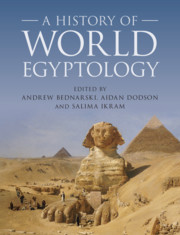Book contents
- A History of World Egyptology
- A History of World Egyptology
- Copyright page
- Dedication
- Contents
- Figures
- Notes on Contributors
- Preface
- A Note on Academic Titles
- Abbreviations and Conventions Used in Text
- Maps
- Introduction
- Chapter 1 The Prehistory of Egyptology
- Chapter 2 Egypt
- Chapter 3 France
- Chapter 4 The British Isles
- Chapter 5 The Netherlands
- Chapter 6 Belgium
- Chapter 7 The Nordic Countries
- Chapter 8 Prussia and Germany
- Chapter 9 The Empire of Austria-Hungary and the Republic of Austria
- Chapter 10 Switzerland
- Chapter 11 Hungary
- Chapter 12 Czechoslovakia
- Chapter 13 Poland
- Chapter 14 Russia
- Chapter 15 Italy
- Chapter 16 Spain
- Chapter 17 United States of America
- Chapter 18 Canada
- Chapter 19 Japan
- Chapter 20 Australasia
- Chapter 21 Ancient Egypt in the Cinema
- Chapter 22 Past and Future
- Bibliography
- Index
Chapter 1 - The Prehistory of Egyptology
Published online by Cambridge University Press: 01 June 2021
- A History of World Egyptology
- A History of World Egyptology
- Copyright page
- Dedication
- Contents
- Figures
- Notes on Contributors
- Preface
- A Note on Academic Titles
- Abbreviations and Conventions Used in Text
- Maps
- Introduction
- Chapter 1 The Prehistory of Egyptology
- Chapter 2 Egypt
- Chapter 3 France
- Chapter 4 The British Isles
- Chapter 5 The Netherlands
- Chapter 6 Belgium
- Chapter 7 The Nordic Countries
- Chapter 8 Prussia and Germany
- Chapter 9 The Empire of Austria-Hungary and the Republic of Austria
- Chapter 10 Switzerland
- Chapter 11 Hungary
- Chapter 12 Czechoslovakia
- Chapter 13 Poland
- Chapter 14 Russia
- Chapter 15 Italy
- Chapter 16 Spain
- Chapter 17 United States of America
- Chapter 18 Canada
- Chapter 19 Japan
- Chapter 20 Australasia
- Chapter 21 Ancient Egypt in the Cinema
- Chapter 22 Past and Future
- Bibliography
- Index
Summary
The first to take an interest in ancient Egypt were, of course, the ancient Egyptians themselves. Prince Khaemwaset, fourth son of Rameses II and high priest of Ptah at Memphis, is often held to have been the first ‘Egyptologist’. He certainly carried out what now might be called ‘heritage’ activities in the Memphite necropolis, (allegedly) restoring monuments and carving large texts identifying their owners on the exteriors of certain examples, including the pyramids of Unas, Userkaf, Menkaure, Djoser, Sahure, Isesi and Senwosret III, as well as the mastaba of Shepseskaf and the sun temple of Niuserre. The prince also dedicated an ancient statue of the Fourth Dynasty prince Kawab in the temple at Memphis. On the other hand, while Khaemwaset was seemingly conserving the memory and importance of these structures, other monuments (including those ancillary to the pyramids in question) were being exploited as stone quarries for his father’s projects. Indeed the ‘labelling’ may well have been a direct result of the demolitions and resulting loss of any external means of identification of the pyramids’ owners. The salvage of material from ancient monuments was of course a phenomenon stretching back into the earliest times, and would continue into the nineteenth century ad.
- Type
- Chapter
- Information
- A History of World Egyptology , pp. 8 - 24Publisher: Cambridge University PressPrint publication year: 2021



